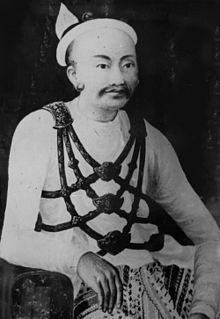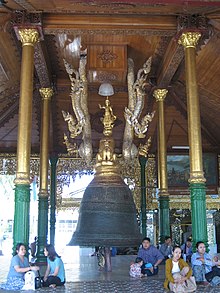
Mindon Min was the penultimate king of Burma (Myanmar) from 1853 to 1878. He was one of the most popular and revered kings of Burma. Under his half brother King Pagan, the Second Anglo-Burmese War in 1852 ended with the annexation of Lower Burma by the British Empire. Mindon and his younger brother Kanaung overthrew their half brother King Pagan. He spent most of his reign trying to defend the upper part of his country from British encroachments, and to modernize his kingdom.

Tharrawaddy Min was the 8th king of the Konbaung Dynasty of Burma. He repudiated the Treaty of Yandabo and almost went to war with the British.

Shin Sawbu was queen regnant of Hanthawaddy from 1454 to 1471. Queen Shin Sawbu was also known as Binnya Thau (ဗညားထောဝ်) or Old Queen in Mon. Queen Shin Sawbu and Queen Jamadevi of Haripunjaya are the two most famous among the small number of queens who ruled in mainland Southeast Asia.

The Shwemawdaw Pagoda is a stupa located in Bago, Myanmar. It is often referred to as the Golden God Temple. At 114 metres (374 ft) in height, the Shwemadaw holds the record for the tallest pagoda in the country although the Shwedagon Pagoda in Yangon is usually credited as the tallest pagoda in Myanmar. Shwemadaw, along with the Shwedagon and Kyaiktiyo, are famous Mon pagodas. The pagoda's annual festival is a 10-day affair that takes place during the Burmese month of Tagu.

Dagon Township is located immediately north of downtown Yangon. The township comprises five wards, and shares borders with Bahan Township in the north, Ahlon Township in the west, Mingala Taungnyunt Township in the east, and Lanmadaw Township, Latha Township and Pabedan Township in the south.

Hti, a Burmese language word meaning umbrella, is the name of the finial ornament that tops almost all Burmese pagodas. The umbrella is an auspicious symbol in Buddhism and Hinduism.

Bago River is a river of southern Myanmar. It flows through Bago and Yangon. It arises in the hills of the Pegu Range and flows into the Myitmaka River which below that point is called the Yangon River.
Singu Min was the fourth king of the Konbaung dynasty of Myanmar. The king, who came to power amid controversy, largely put an end to his father Hsinbyushin's policy of territorial expansion, which had severely depleted the kingdom's manpower and resources. He stopped his father's latest war against Siam at his accession, effectively ceding Lan Na to the Siamese. Likewise, he took no action when the Laotian states stopped paying tribute in 1778. The only campaigns were in Manipur, where the Burmese army was forced to put down four rebellions throughout his reign.

Uppātasanti Pagoda is a prominent landmark in Naypyidaw, the capital of Myanmar. The pagoda houses a Buddha tooth relic from China. It is nearly a same-sized replica of Shwedagon Pagoda in Yangon and stands 99 metres (325 ft) tall.

The Maha Wizaya Pagoda is a pagoda located on Shwedagon Pagoda Road in Dagon Township, Yangon, Myanmar. The pagoda, built in 1980, is located immediately south of the Shwedagon Pagoda on Dhammarakhita Hill. The enshrined relics were contributed by the King of Nepal, while the pagoda's hti (umbrella) was consecrated by Ne Win, the country's former leader. The construction of this particular pagoda is believed by some scholars to have been a form of merit-making on the part of Ne Win.

The Shwezigon Pagoda Bell Inscription is a multi-language inscription found on the Shwezigon Pagoda Bell, donated by King Bayinnaung of Toungoo Dynasty and located at the Shwezigon Pagoda in Bagan, Burma (Myanmar). Written in Burmese, Mon, and Pali, the inscription lists the important events in the first six years of his reign. It is the only contemporary record in Burmese that calls the king "Conqueror of the Ten Directions", the title by which he is widely known in Mon and Thai.
Pazundaung Creek is a stream that empties into Yangon River. The center of Rangoon was established at the confluence of Yangon River to the west and south and Pazundaung Creek to the east. The areas surrounding Pazundaung Creek have high concentrations of Burmese Indians. The Great Bell of Dhammazedi, one of the largest bells in the world, sank into the creek in 1608, when Filipe de Brito e Nicote, then governor of Syriam, removed it from the Shwedagon Pagoda.

The Tharrawaddy Min Bell, also known as the Maha Tissada Gandha Bell, is a large bell located at the Shwedagon Pagoda in Yangon, Myanmar (Burma). It was donated in 1841 by King Tharrawaddy, of Konbaung Dynasty. The official Pali name of the bell is Maha Tissada Gandha, which means "Great Three-toned Sweet Sound".

Maung Htaw Lay was Magistrate of Moulmein (Mawlamyine) from 1838 to 1853 during the early British colonial period of Myanmar (Burma), and governor of Dala from 1805 to 1827 during the Konbaung period. Prior to his defection to the British in 1827, he had been a Royal Burmese Army commander, and had fought in the First Anglo-Burmese War (1824–26). At Moulmein, Htaw Lay became one of the most senior indigenous officials in the colonial government. He moved to Yangon (Rangoon) in 1853 after the British annexation of Lower Burma. He successfully used his influence with the colonial government to stop the occupation forces' pillaging of Buddhist shrines around Yangon, and with the help of his son-in-law Maung Khaing, spent the rest of his life restoring the Shwedagon Pagoda.

Alanpya Pagoda is a 98.33-foot-tall (29.97 m) Burmese pagoda located on Alanpya Hill, on the southern part of Dhammarakhita Hill, in Yangon, Myanmar. The pagoda is south of Maha Wizaya Pagoda.

The architecture of Myanmar, in Southeast Asia, includes architectural styles which reflect the influence of neighboring and Western nations and modernization. The country's most prominent buildings include Buddhist pagodas, stupas and temples, British colonial buildings, and modern renovations and structures. Myanmar's traditional architecture is primarily used for worship, pilgrimage, storage of Buddhist relics, political activism and tourism.

Kyaikhtisaung Pagoda is a Buddhist pagoda in Bilin, Mon State, Myanmar.
Yaza Dewi was a principal queen of King Binnya Ran I of Hanthawaddy. She was most likely the king's chief queen consort since the 1485/86 Shwedagon Pagada inscriptions by King Dhammazedi list King Binnya Ran I and Queen Na Yaza Dewi as the royal donors in 798 ME (1436/37).
Ye Mibaya was a principal queen of King Binnya Waru of Hanthawaddy. She was most likely the king's chief queen consort since the 1485/86 Shwedagon Pagada inscriptions by King Dhammazedi list King Binnya Waru and Queen Ye as the royal donors at the pagoda.





















